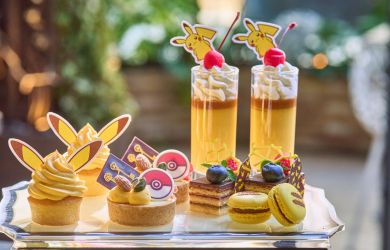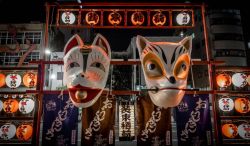
January 13, 2011
Seoul Kitchen
Take home an authentic taste of Kankoku with these essential Koreatown treats
By Metropolis
Originally published on metropolis.co.jp on January 2011
Harim Samgyetang

Photos by Daniel Robson
If you’ve ever experienced a freezing Korean winter, you’ll appreciate the warming effect of a steaming bowl of samgyetang—though, in fact, the dish is traditionally eaten in summer too. Each bowl features a whole young chicken stuffed with sticky rice and vegetables in a broth of ginseng, jujube fruit, garlic and ginger; the flesh becomes so soft it falls easily from the bones, and the soup is loaded with healthful nutrients. Several brands offer ready-made samgyetang to eat at home; Harim’s is cooked and frozen in Korea before export, keeping the flavor fresh and the meat succulent, and there’s a whole chick in every pack. Simply boil in the bag for the perfect remedy for those winter sniffles. ¥960 from Kankoku Hiroba supermarket
Hakusai Kimchi
 It wouldn’t be an authentic meal without kimchi. People in the Land of the Morning Calm have been eating countless variants of this side dish for nearly 3,000 years. And who can blame them? Kimchi is low in calories and high in fiber and vitamins, and it’s served gratis in most restaurants. This pack, made fresh on the premises, came from the Seoul Ichiba supermarket on Okubo Dori, but shops and eateries all around Koreatown sell their own versions. You can enjoy kimchi on its own or toss it into a nabe to make a fiery broth. Seoul Ichiba’s generous range also includes kyuri kimchi, made with cucumber; kakuteki, with chunks of daikon; and togarashi, hot chilies in a soy-based sauce. ¥500/500g bag from Seoul Ichiba supermarket
It wouldn’t be an authentic meal without kimchi. People in the Land of the Morning Calm have been eating countless variants of this side dish for nearly 3,000 years. And who can blame them? Kimchi is low in calories and high in fiber and vitamins, and it’s served gratis in most restaurants. This pack, made fresh on the premises, came from the Seoul Ichiba supermarket on Okubo Dori, but shops and eateries all around Koreatown sell their own versions. You can enjoy kimchi on its own or toss it into a nabe to make a fiery broth. Seoul Ichiba’s generous range also includes kyuri kimchi, made with cucumber; kakuteki, with chunks of daikon; and togarashi, hot chilies in a soy-based sauce. ¥500/500g bag from Seoul Ichiba supermarket
Shindandong Instant Tteokbokki
 Tteokbokki is another beloved Korean dish, and the streets of Seoul are lined with stall after stall selling the piping hot stew of mochi, fish cakes, meat and vegetables in a bright red chili sauce. Though it originally dates back to the royal courts of the Joseon Dynasty, the dish exploded in popularity with the commoners when chili-loaded gochujang paste and fish cakes were added in the early ’50s. Shindandong, named after a famous tteokbokki district, is a simplified version for the microwave. Inside the tub you’ll find a pack of those distinctive sausage-shaped glutinous rice cakes, a sachet of tangy, spicy sauce, a handy measuring cup and a fork—mix it all up and sling in the microwave for a few minutes for an instant hot Seoul snack. ¥290 from Seoul Ichiba supermarket
Tteokbokki is another beloved Korean dish, and the streets of Seoul are lined with stall after stall selling the piping hot stew of mochi, fish cakes, meat and vegetables in a bright red chili sauce. Though it originally dates back to the royal courts of the Joseon Dynasty, the dish exploded in popularity with the commoners when chili-loaded gochujang paste and fish cakes were added in the early ’50s. Shindandong, named after a famous tteokbokki district, is a simplified version for the microwave. Inside the tub you’ll find a pack of those distinctive sausage-shaped glutinous rice cakes, a sachet of tangy, spicy sauce, a handy measuring cup and a fork—mix it all up and sling in the microwave for a few minutes for an instant hot Seoul snack. ¥290 from Seoul Ichiba supermarket
Market O Real Brownie
 The Korean brand Market O claims to use all-natural ingredients in its confectionery line and at its restaurants—and one bite of these gorgeous brownies is enough to make you happily believe it. Each individually wrapped 20g cake is a moist, rich, chocolatey revelation, the sort of perfect brownie Mom used to make and that you’ve pined for ever since you moved to Japan. In Koreatown stores you can also find Market O water crackers and large boxes of baked potato chips; while the former look like they’d go great with a slice of Camembert and the latter with a glass of dry white wine, it’s the brownies that have the most obvious perfect pairing: heat them up and add a dollop of ice cream for an oozing, to-die-for extravagance. ¥300 (pack of four) from Star Shop
The Korean brand Market O claims to use all-natural ingredients in its confectionery line and at its restaurants—and one bite of these gorgeous brownies is enough to make you happily believe it. Each individually wrapped 20g cake is a moist, rich, chocolatey revelation, the sort of perfect brownie Mom used to make and that you’ve pined for ever since you moved to Japan. In Koreatown stores you can also find Market O water crackers and large boxes of baked potato chips; while the former look like they’d go great with a slice of Camembert and the latter with a glass of dry white wine, it’s the brownies that have the most obvious perfect pairing: heat them up and add a dollop of ice cream for an oozing, to-die-for extravagance. ¥300 (pack of four) from Star Shop
Orion Peanut Snacks
 Although peanuts don’t naturally grow in Korea, they’ve been integrated into many popular confections. Arguably the most delicious of all is Orion peanut snacks, little balls of peanuts and puffed rice covered in sticky sugar. They’re so crunchy that every mouthful triggers a series of cranial explosions, and an 80g packet doubtless represents a week of future dental work and a significantly increased risk of diabetes. But hey, if we wanted to be healthy all the time, we wouldn’t be eating snacks, and if we weren’t eating snacks, we’d never know how utterly irresistible these sugary little buggers are. Orion peanut snacks, then—they make life that tiny bit sweeter. ¥150 from Star Shop
Although peanuts don’t naturally grow in Korea, they’ve been integrated into many popular confections. Arguably the most delicious of all is Orion peanut snacks, little balls of peanuts and puffed rice covered in sticky sugar. They’re so crunchy that every mouthful triggers a series of cranial explosions, and an 80g packet doubtless represents a week of future dental work and a significantly increased risk of diabetes. But hey, if we wanted to be healthy all the time, we wouldn’t be eating snacks, and if we weren’t eating snacks, we’d never know how utterly irresistible these sugary little buggers are. Orion peanut snacks, then—they make life that tiny bit sweeter. ¥150 from Star Shop
Pocheon Ildong Burned-rice Makgeolli

Perusing the booze aisles at Kankoku Hiroba supermarket, we admit to being baffled by the choice of makgeolli. It’s nearly impossible to select an authentic makgeolli in Japan, since they are relabeled with new Japanese names; and in any case, the good stuff in Korea often comes in cheap-looking plastic bottles rather than anything fancy. After asking three staff members for their recommendation and having each reply that they don’t drink, we went for the one with the longest pedigree: Pocheon Ildong, brewed since 1932. Big mistake. Where makgeolli should be smooth and creamy with a slight fizz, this has the overpowering taste of burned rice, with a lingering wheaty aftertaste; we’d have been better off with the bottle of E-don makgeolli that had almost made it into our basket instead. On the bright side, we’ve saved you from making that mistake yourself. Aren’t we lovely? ¥498 from Kankoku Hiroba supermarket
For shop details, see Feature.




-390x250.jpg)


